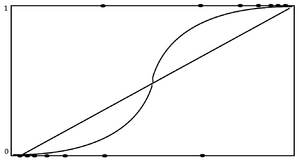Logistic Regression
Logistic regression is a linear method. Taking one or multiple input values (x), logistic regression models will provide one output value (y). The output value in logistic regression is a binary value. Due to the binary output, interpreting the results are not within the scope of these linear methods. Rather, the accuracy of the predictions is focused on.
Logistic regression models the probability of an outcome. The probability is then transformed into a binary value based on the most likely outcome. This is all done by estimating the values of the coefficients (βn).
Though the method is linear (as it assumes a linear relationship between the input and output variables), the prediction undergoes a non-linear transform to provide the output as a binary value.
In the following image[1], the straight line represents a linear solution and the s shape represents a logistic solution. The logistic s-shaped curve provides a more accurate representation of the probability of a datapoint being a 1 or a 0 in the image.
Preparing data for a logistic regression model
• The output must be a binary value. This model is used for binary classification problems.
• Logistic regression assumes no error in the output variable. Removing outliers and any misclassified information from the dataset is beneficial.
• The data should fit a rough Gaussian distribution to best represent the linear relationship between the input and output values. Transforming the dataset to expose this relationship will improve the performance of the model.
• The model can overfit if there are multiple highly correlated inputs variables
• If there are highly correlated input variables, or if the data is sparse, it is possible that the estimation calculations for the values of the coefficients will fail to converge.

